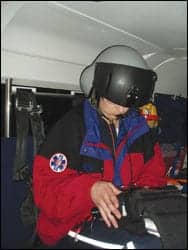 |
The LIFE STAR critical care air medical transport service began operation in 1985 and is the only critical care helicopter in Connecticut. LIFE STAR operates two American Eurocopter BK-117 twin-engine helicopters 24 hours a day, 7 days a week. One aircraft is based on the rooftop helipad at Hartford Hospital in Hartford; the other is based at The William W. Backus Hospital in Norwich. LIFE STAR is available to all emergency/critical care patients within a 150-mile radius of its bases. LIFE STAR services all tertiary care centers within this response area, and approximately 1,500 patients are transported annually—more than 20,000 patients to date. LIFE STAR was recently reaccredited by the Commission on Accreditation of Medical Transport Systems (CAMTS), which is dedicated to improving the quality of patient care and safety of the transport environment or services providing rotor wing, fixed wing, and ground transport systems. Certification implies a high level of quality in the medical transport organization. The voluntary accreditation, which is for 3 years, is the result of a site visit and a thorough review of documentation for all aspects of the program, including education, safety, patient care, the quality assurance process, and aircraft maintenance schedules.
Each LIFE STAR helicopter is identical in the composition of its crew and capabilities and can transport two patients. The crew consists of a flight nurse, flight respiratory therapist, pilot, mechanic, and communication specialist. The inclusion of a flight nurse and flight RT on every flight is unique to LIFE STAR. The service does not utilize specialty teams for neonatal or intra-aortic balloon pump (IABP) patient transports, as the diverse knowledge base, critical thinking, and advanced skills of this team allow it to meet all medical challenges of the critically ill and injured patients transported by LIFE STAR. The LIFE STAR flight nurses hold licenses as RNs and also as Connecticut paramedics. They also hold at least one specialty certification (CEN, CCRN, or CFRN), and have 3 or more years of critical care experience upon hire. Each flight respiratory therapist is an RRT and EMT-B—EMT-P preferred—with at least 3 years of critical care experience. In addition, all medical crew members are required to have certifications in BLS, ACLS, PALS, and NRP.
 |
| LIFE STAR transports a patient to a waiting ambulance. |
After undergoing a rigorous pre-employment screening process, new medical crew members participate in an extensive competency-based 6-month orientation and training program. This program includes clinical rotations comprising didactic training from attending physicians; flight transport shifts with a preceptor; competency training; and safety, equipment, patient population, and standard of practice orientation and training. The didactic portion of the medical crew orientation is developed based on areas of weakness identified during the assessment process. Candidates with extensive experience in specific areas such as neonatology, pediatrics, trauma, cardiology, and obstetrics may be administered an oral board type-examination to demonstrate competency with this knowledge set. During this didactic period, also, the orientee will begin flight observation shifts. These are strictly observational and are designed to add practicality to the didactic component. Based on assessment, each candidate will go to the adult and pediatric operating room to gain experience in endotracheal tube placement. All candidates are required to have 10 successful intubations in each week of OR experience. A total of 55 intubations should be performed while in orientation, 25 of which can be in the simulation center. The remainder can be performed in the OR, emergency department, or field. Ten intubations must be obtained prior to intubating on the aircraft during orientation. This number of intubations can be adjusted based on need and experience.
 |
| The LIFE STAR helipad. |
In addition to receiving medical lectures, each candidate will receive lectures on aircraft safety, continuous quality improvement processes, basic survival, water survival, and air medical resource management. Air medical resource management was conceived to enhance the safety culture within the air medical industry by promoting team building and open, effective communication. This is a yearly requirement of all LIFE STAR disciplines. Each candidate will successfully complete procedures performed in an animal surgical skills laboratory, including needle cricothyrotomy, transtracheal jet ventilation, surgical cricothyrotomy, needle thoracostomy, chest-tube placement followed by open thoracostomy, pericardiocentesis, and escharostomies. Each candidate will be trained on LIFE STAR-specific equipment. This can occur during didactic training or preceptor training. The precepting of the flight crew members begins upon completion of these stages. If, at any time, the medical crew candidates fail to demonstrate adequate knowledge or skills competency, they will receive additional training/education to fill the deficit. Each precepting experience varies in length of time and is based on flight volume, as well as on input from the preceptor. The service monitors flight type (scene, interhospital, as well as diagnosis category) volumes to ensure that each candidate has been observed to be successful at all aspects of air medical transport before release from preceptorship. After each flight, a postflight debrief is filled out by the crew members, including the orientee. This debrief assesses the candidate’s clinical performance and communication skills during the flight. For a candidate to be cleared to fly independently, three tasks must be accomplished: 1) successful completion of an examination for each section of LIFE STAR’s standards of care; 2) successful completion of a series of patient care scenarios using the human patient simulator (HPS); and 3) successful completion of oral board examinations in neonatology, high-risk OB, cardiology, IABP validation, pediatrics, and trauma.
The LIFE STAR program uses a high-fidelity human patient simulator with real-time dynamic case moderation and progression to exercise clinical skills during initial orientation, in continuing education, and in high-risk, low-frequency (HRLF) cases. The HRLF cases are defined as those with a diagnosis of high-risk obstetrics, toxicology, neonatal, and difficult airway. The HPS experience is moderated by two senior flight nurses and two senior flight respiratory therapists, with more than 5 years of team-leader experience in this transport program and specialty training and experience in the HPS center, and by the director of the simulation center at Hartford Hospital, who has critical care experience and extensive HPS operational and technical experience. The Laerdal SimMan and Simfant provide full physiologic monitoring capabilities for NIBP; AB; heart rate; respiratory rate; Spo2; ETco2; temperature; lung and heart sounds; and central and peripheral pulses. Procedures such as oral and nasal airway procedures, both intra- and extra-glottic, surgical airway procedures, gastric intubation, and central venous access can be performed on the HPS manikins. The presentation for each case also includes prerecorded radio traffic for dispatch and en route patient information and a complete mock patient record. Staff receive a bedside report, perform a patient interview and assessment, provide on-site and en route care, and provide radio and bedside reports for the receiving center. Scenario-driven HPS sessions are recorded on DVD and include the use of objective evaluation tools for clinical performance and team interaction. For initial training, clinical staff orientees perform scenarios from clinical topics, including ACLS; PALS; NRP; cardiogenic shock; toxic ingestions; GI bleed; ischemic and hemorrhagic stroke; aortic dissection; MI; OB; neurotrauma; pediatric trauma, sepsis, and asthma; preterm labor; and IABP.
During the first year of independent practice, each new crew member must fly with another medical crew member who has more than 6 months of experience. Also during this time, candidates obtain performance reviews from their medical crew partners. Before they are released to fly with any other crew member, their discipline-specific leadership observes them during at least one flight shift. Each new crew member is paired with a mentor, a more senior crew member, to guide them through many of the logistical considerations involved in transport medicine.
 |
| Inside a LIFE STAR transport helicopter. |
Ongoing education is a mandatory integral part of the LIFE STAR flight team. Biweekly continuous quality improvement (CQI) meetings include flight/case review as well as other required topics. CQI is an ongoing cycle of evaluation, data collection, interpretation, and modifying the system to improve patient care. CQI is a never-ending loop, with the primary goal of improving the delivery of health care. Annual skills day is a requirement for the medical crew members, also. It validates use of all onboard medical equipment and competencies in specialty equipment and procedures such as IABP, ventriculostomy, ventilator management, central venous access, adult and pediatric intraosseous placement, and neonatal umbilical line cannulation. Along with the annual skills day, the medical crew members are required to complete an animal surgical laboratory to maintain proficiency in surgical skills. For recurrent training, clinical staff rotate through the HPS program twice each calendar year. One set of scenarios is drawn from clinical topics: toxicology (overdose, transfusion reaction), high-risk obstetrics (preeclampsia, eclampsia, preterm labor), and neonatal emergencies (septic shock, respiratory distress, congenital heart defects).
 |
Editor’s note
More on
Emergency Transport
In addition, mandatory training for all LIFE STAR disciplines includes annual training on altitude physiology, stress management, survival training, and Safety Day. These requirements validate competency in the following areas: cockpit emergency procedures, fire suppression systems on board aircraft and helipad, hazardous material awareness, emergency engine shutdown, and emergency location transmitter procedures. In addition to aircraft safety meetings, all crew members attend emergency egress training. This teaches aircraft crew members who travel over water the knowledge and skills necessary to react to an aircraft-ditching emergency using the modular egress training simulator.
LIFE STAR’s comprehensive training program is designed to build on a medical flight crew’s continuing education to enhance their abilities and experience.
Dawn Filippa, RRT, EMT-P, is a flight respiratory therapist with LIFE STAR.










